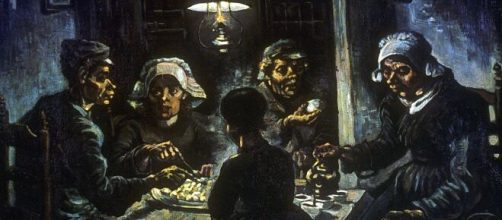When you think of Van Gogh, thoughts of a painter plagued by mental problems likely come to mind. If the crazed way Kirk Douglas played him in the ’56 biopic “Lust for Life” didn’t inform you, certainly last year’s show at the Van Gogh Museum titled “On the Verge of Insanity” nailed the image.
But a new show at the Van Gogh Museum will have you re-thinking the image that the movie and museum planted in your mind. The show, titled “The Potato Eaters, Mistake or Masterpiece?” presents letters and never-seen-before preparatory sketches that make plain that Van Gogh was a careful planner who knew exactly what he was doing.
And he didn’t hesitate to record his plans in both words and pictures.
The painting was lambasted by Van Gogh’s friend and fellow painter Anthon van Rappard, who faulted the figures’ proportion saying in a letter, “you can do better than this.” He disagreed and wrote to his sister that "The Potato Eaters" was one of the best things he’d ever done.
Best laid plans
Wanting to make another version on the same subject makes the artist's point that he deemed the work a success. Many painters make variations of their favorite works. Monet, for example, painted his pictures of Haystacks dozens of times.
Unaccountably, the museum’s tagline for the show title – “Mistake or Masterpiece?” – calls Van Gogh’s careful planning into question.
This, even though his letters make it so pristinely clear that he knew what he was about.
Reacting to his friend Anton van Rappard’s criticism about the proportion of his figures, the artist wrote to his brother: “What I’m trying to get is not a hand but the gesture, not a mathematically correct head but the overall expression.”
Bregje Gerritse, the exhibit curator told The Guardian: “I really like that Van Gogh stands behind his own work.” So what’s with the questioning show title?
Written proof
This is not the first time this museum has made the painter out to be something he’s not. I’m thinking of its show title last year that cast him as a madman, "On the Verge of Insanity." It’s as if this exhibit hall thinks that if audiences saw the artist as a careful thinker, they will lose interest.
How else to explain the museum’s disregard of research published in 2011 that indicated Van Gogh didn’t kill himself. Instead, he was murdered. His biographers Steven Naileh and Greg White Smith offered evidence that he was shot by teasing teens.
Rather than acknowledge that finding, the museum continues to paint the artist as unstable. A museum spokesman even went so far as to tell The Guardian that the look of Van Gogh’s gloomy-looking self-portraits "is often found in patients suffering from depression and psychosis.”
But here’s the thing. This museum's current show of the artist’s preparatory drawings for "The Potato Eaters" unwittingly proves that he was not suicidal. It was the month he died when he wrote to Theo enthusing about making another version of a favorite picture. Not the words of someone about to take his own life.


